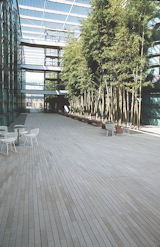Drawing the Line: Concrete Pavers That Advance Architectural Design
Architecture, at its most elemental, depends on the arrangement of lines in space. Whether these lines are the exuberant curves of Frank Gehry or the skeletal frameworks of Ludwig Mies van der Rohe, they fundamentally shape the structure and the landscape around it. It is precisely this building block of design that Stepstone embodies with its collection of precast concrete Linearity Pavers. After 40 years of leading the industry, the Los Angeles–based company is bringing it back to the basics by manufacturing pavers that help express the original vision of architects, landscape architects, and designers.
"We provide homeowners and architects with the opportunity to find the paver that enhances the shapes of their own projects," says Stepstone owner Gordon McWilliams. "Our products are part of the project environment." Here, Pedestal Set Roof Pavers set the scene for a graphic lounge area at the Micropolitan apartments in Los Angeles, California.
Linearity—the line that characterizes a project, and the line that gives shape to Stepstone’s pavers—is a concept realized by the company’s owner, Gordon McWilliams. "It’s a word that allows us to draw ourselves more closely to what the architect is trying to accomplish," he explains. An Air Force veteran with a talent for sales and marketing, McWilliams took over Stepstone in 1976 after having proved his chops in the industry. Over the years, he’s grown the workforce from 6 to 160 employees and expanded it to three locations.
Throughout its history, Stepstone has been dedicated to offering a rich product line that speaks to the varied needs of its customers—developing its own molds, providing unique finishes and sizes, and continually producing new products in the paver, stair tread, pool coping, and wall cap categories.
Stepstone nurtures its relationships with architects, designers, engineers, building suppliers, and homeowners for insight into their evolving needs, which in turn sparks innovation. For example, collaborations with renowned landscape architect Peter Walker led to the development of the Narrow Modular Paver, an elongated brick, for the Stanford University Campus, and the undulating Wave Paver for the Colorado Esplanade in Santa Monica, California. "Building architects and landscape architects coordinate their designs to complement each other and tell a story in some way," says McWilliams. "So, we’ve created pavers where the line is very important, that are both attractive to the setting and strong enough to do the job."
Lisa Kruger, sales and marketing analyst at Stepstone, elaborates, "Over time, technology has allowed us to get more creative with our shapes. It’s also allowed us to enhance our production even though everything is made and finished by hand. The whole idea behind Linearity is to emphasize musicality and poetry."
And while concrete pavers and musicality are not often associated, Stepstone does bring a level of craftsmanship and virtuosity that expands the possibilities of landscaping. In fact, talking about his conception of Linearity Pavers, McWilliams muses, "It was time for me to write a song."
Published
Get the Dwell Newsletter
Be the first to see our latest home tours, design news, and more.







